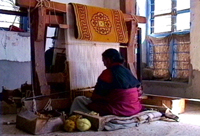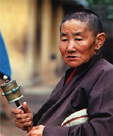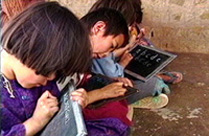


It was Khamtrul Rinpoche’s vision to establish a traditional Tibetan community for the preservation and perpetuation of Tibet’s endangered culture, sacred arts, and Buddhist heritage. After ten years of arduous wandering, Khamtrul Rinpoche fulfilled his vision. Nestled in the foothills of the Himalayas on thirty-four acres of land, not far from the Dalai Lama in Dharamsala, Khamtrul Rinpoche established the community of Tashi Jong (the name means Auspicious Valley.) and Khampagar Monastery.
This inspiring documentary portrays how the vitality of the community's faith and determination permeates all activities, sacred and ordinary. The penetrating photography takes us on an intimate journey through the daily life of this community of three hundred lay people and one hundred monks.We see lay people engaged in the traditional arts and crafts of carpet weaving and woodblock carving; a nun bending to sweep a courtyard while chanting prayers; an elderly woman walking down a footpath with a spinning prayer wheel in hand; and a master lay artist painting a sacred Buddhist scroll (thangka) with devotion and unbroken concentration.
We visit the Tashi Jong school, where children are learning English
to prepare them for the modern world and Tibetan to sustain their
cultural identity, and a secluded yogi Togden (one who has attained
realization) teaching a monk the ancient Tibetan medical art of
pulse diagnoses and herb preparation. We enter the sacred prayer
hall, where the young ninth Khamtrul Rinpoche (b.1980) sits on
a high platform presiding over Buddhist prayers and rituals, and
we join a truckload of community members who travel to a nearby
Indian town to participate in the annual March 10th commemoration
of Tibetan Uprising Day.
The video culminates in a stunning visual feast of sacred lama dances that were first performed in Tibet more than 300 hundred years ago. Khamtrul Rinpoche carried the knowledge of these dances into exile, and they have been performed faithfully ever since. Dressed in elaborate costumes of silks and brocades, with some dancers wearing intricately carved and painted masks, the monks dance in highly stylized movements. Solemn chanting and rich tones of traditional temple instruments accompany the dancers, creating a meditation in sound and movement. This sacred ritual concludes with the community gathered in a large circle as the lamas pass each bowed head, bestowing the blessings of peace that have been gathered during the ritual. Against a backdrop of the snow-covered Himalayan mountains, the constant beat of drums extends these blessings to the people of Tibet and to all people everywhere.
The atmosphere of this poetic documentary is endowed with a sense of harmony, compassion, and serenity. Tashi Jong seeks to reveal how the indomitable spirit of the Tibetan people remains unbroken after forty years of hardship in India and how, with faith, devotion, and courage, they have continued to preserve their ancient heritage as a living reality in exile. The narration, imbued with Buddhist teachings, is spoken by a Tibetan woman and is based on the thoughts and words of the spiritual teachers and lay people of the Tashi Jong community.